High Impact Tutoring Built By Math Experts
Personalized standards-aligned one-on-one math tutoring for schools and districts
3D shapes
Here you will learn about 3D shapes, including their names and properties and how to identify and classify 3D shapes.
Students will first learn about 3D shapes in 1 st grade with their work in geometry, identifying and classifying shapes by their properties. They expand their knowledge of 3D shapes as they progress through elementary and middle school.
What are 3D shapes?
3D shapes (three-dimensional shapes) are solid shapes that have 3 dimensions: height, width and depth (all line segments).

Here are some familiar 3D shapes:
| Cube | Cone | Pyramid
shape | Cylinder |
|---|---|---|---|
 |  |  |  |
Faces, edges and vertices
Polyhedra are 3D shapes made up of faces, edges and vertices as illustrated below.
| Face
A flat 2D shape surrounded by edges and vertices. |  |
|---|---|
| Edge
A straight line where two faces meet and connect two vertices |  |
| Vertex
A point where two or more edges meet (like a corner) |  |
The shape in the table is a cube. It has 6 faces, 12 edges and 8 vertices.
Properties of 3D Shapes
3D shapes can be categorized in several ways. A 3D shape is either a polyhedra or a non-polyhedra.
3D shapes can then be further categorized as shown in the table below. The properties of 3D shapes can help to classify them and recall their names.
| Name of polyhedra | Properties of polyhedra |
|---|---|
Rectangular prism A rectangular prism can be described as a cuboid.  Rectangular prism |
● 6 faces
|
Triangular prism  Triangular prism |
● 5 faces
|
Square pyramid  Square Pyramid |
● 5 faces
|
Triangular pyramid (tetrahedron)  Triangular Pyramid |
● 4 faces
|
| Name of non-polyhedra | Properties of non-polyhedra |
|---|---|
Sphere A sphere can be described simply as a ball.  Sphere shape |
● All dimensions (length, width |
Cylinder A cylinder can be described as ‘prism-like’ with a circular base.  Cylinder |
● 2 circular bases
|
Cone A cone can be described as ‘pyramid-like’ with a circular base.  Cone |
● 1 circular base
|
Step-by-step guide: 3D shape names
Step-by-step guide: Pyramid shape
![[FREE] 3D Shape Worksheet (Grade 1, 5 and 6)](https://thirdspacelearning.com/wp-content/uploads/2023/11/3D-Shape-listing-image.png)
[FREE] 3D Shape Worksheet (Grade 1, 5 and 6)
![[FREE] 3D Shape Worksheet (Grade 1, 5 and 6)](https://thirdspacelearning.com/wp-content/uploads/2023/11/3D-Shape-listing-image.png)
Use this quiz to check your grade 1, 5 and 6 students’ understanding of 3D shape. 10+ questions with answers covering a range of 1st, 5th and 6th grade 3D shape topics to identify areas of strength and support!
DOWNLOAD FREE![[FREE] 3D Shape Worksheet (Grade 1, 5 and 6)](https://thirdspacelearning.com/wp-content/uploads/2023/11/3D-Shape-listing-image.png)
[FREE] 3D Shape Worksheet (Grade 1, 5 and 6)
![[FREE] 3D Shape Worksheet (Grade 1, 5 and 6)](https://thirdspacelearning.com/wp-content/uploads/2023/11/3D-Shape-listing-image.png)
Use this quiz to check your grade 1, 5 and 6 students’ understanding of 3D shape. 10+ questions with answers covering a range of 1st, 5th and 6th grade 3D shape topics to identify areas of strength and support!
DOWNLOAD FREEVolume and surface area of 3D shapes
You can find the volume and surface area of 3D shapes.
The volume of a 3D shape is the amount of space there is inside the shape.

See also: Volume
Surface area is the total area occupied by the surface of a 3D shape.
To find the surface area of a prism, cylinder, or pyramid, it is often helpful to draw the net of the 3D shape, calculate the area of each face, and then add them together.

See also: Surface area
What are 3D shapes?

Common Core State Standards
How does this relate to 1 st grade math?
- Grade 1: Geometry (1.G.A.2)
Compose two-dimensional shapes (rectangles, squares, trapezoids, triangles, half-circles, and quarter-circles) or three-dimensional shapes (cubes, right rectangular prisms, right circular cones, and right circular cylinders) to create a composite shape, and compose new shapes from the composite shape.
How to identify 3D shapes
In order to identify a 3D shape, you will:
- State the characteristics of the given shape.
- Recall the definitions of the different 3D shapes and state which 3D shape the shape is.
3D shapes examples
Example 1: identifying 3D shapes
What is the name of this 3D shape?
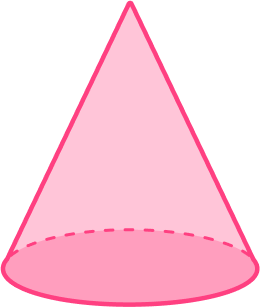
- State the characteristics of the given shape.
The given shape has 1 circular base, 1 curved side that meets at the 1 apex on the shape.

2Recall the definitions of the different 3D shapes and state which 3D shape the shape is.
Based on the characteristics of the given shape, the shape is a cone.
Example 2: identifying 3D shapes
Edward is giving Nancy directions to draw a given 3D shape. Edward tells Nancy that the shape has a square base with 4 triangular faces, 8 edges and 5 vertices. What shape is Edward describing to Nancy?
State the characteristics of the given shape.
Edward tells Nancy that the shape has a square base with 4 triangular faces, 8 edges and 5 vertices.
Recall the definitions of the different 3D shapes and state which 3D shape the shape is.
Nancy recalls the shapes that she is familiar with that have a square base,

She now needs to look and see which have 4 triangular faces.
The rectangular prism and cube only have rectangular faces. These are not the shapes Edward was describing.

The triangular prism has 2 triangular faces and 3 square faces. This is not the shape Edward was describing.

The square pyramid has 1 square base and 4 triangular faces. It also has 8 edges and 5 vertices.

Edward was describing a square pyramid to Nancy.
Example 3: real-world example
Look at the image below and determine which 3D shape it is.

State the characteristics of the given shape.
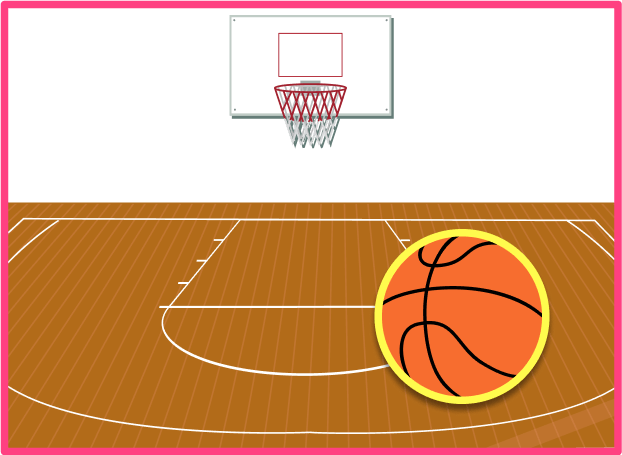
The shape is a basketball, where all dimensions are the same. The center point will be equal from every point on the surface.
Recall the definitions of the different 3D shapes and state which 3D shape the shape is.
This shape is a sphere.
Example 4: real-world example
Look at the image below and determine which 3D shape it is.

State the characteristics of the given shape.
This shape has a square base with 4 triangular faces ( 2 showing) and has 5 vertices ( 4 showing).

Recall the definitions of the different 3D shapes and state which 3D shape the shape is.
This shape is a square pyramid.
How to identify 3D shapes in a composite shape
In order to identify 3D shapes in a composite shape, you will:
- Count the number of shapes that make up the composite shape.
- Identify and state the number of each type of shape within the composite shape.
Example 5: identifying 3D shapes in a composite shape
Look at the composite shape and identify all 3D shapes.
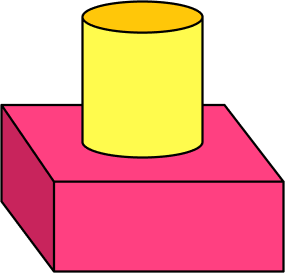
Count the number of shapes that make up the composite shape.
There are two shapes in this composite shape.
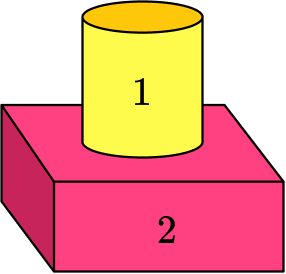
Identify and state the number of each type of shape within the composite shape.
Shape 1 has 2 circular bases with a smooth, curved lateral face. Shape 1 is a cylinder.
Shape 2 has 6 rectangular faces that meet at vertices. Shape 2 is a rectangular prism.
Example 6: identifying 3D shapes in a composite shape
Look at the composite shape and identify all 3D shapes.

Count the number of shapes that make up the composite shape.
There are \bf{7} shapes in this composite shape.

Identify and state the number of each type of shape within the composite shape.
Shapes 1, 2 and 4 have 6 rectangular faces and are rectangular prisms. Shapes 1 and 2 are also classified as cubes.
Shape 3 has two rectangular faces and 3 rectangular faces. Shape 3 is a triangular prism.
Shapes 5 and 6 have 2 circular bases with a smooth, curved lateral face. These shapes are cylinders
Shape 7 has 1 circular base, 1 curved surface and 1 vertex. Shape 7 is a cone.
Teaching tips for 3D shapes
- Find a 3D shapes song for kids to introduce and reinforce important vocabulary and concepts. Songs often contain repetitive lyrics, which reinforce the material being learned, so when students listen to or sing a song repeatedly, the information becomes ingrained in their working memory and helps recall.
- Teach terms like faces, edges, vertices, and base and incorporate these terms during discussions and activities.
- Printable worksheets that show a variety of 3D shapes or real-life examples can be useful for students to practice with. Students need to practice not being able to “see” all sides of the geometric shape, but still identify all the characteristics.
Easy mistakes to make
- Using the wrong formula
There are several formulas for surface area and volume. Make sure you select the right one by correctly identifying the 3D shape in the question and what it is asking you to calculate.
- Using a mixture of units in a calculation
When you are calculating volume or surface area, you must ensure that the units of length you are using are the same. This may mean that you need to convert a unit before you carry out a calculation. For example, if one length is given in meters and another is given in centimeters, you must convert one of them so that they are either both in meters or both in centimeters.
- Missing or incorrect units
You should always include units in your final answer.
Surface area is measured in square units (for example, mm^{2}, cm^{2}, m^{2}, etc.).
Volume is measured in units cubed (for example, mm^{3}, cm^{3}, m^{3}, etc.).
For volume, you may also be asked to give your answer in liters or millimeters for example. Note that,
1 \, ml = 1 \, cm^{3}
1 \, liter = 1000 \, ml = 1000 \, cm^{3}
- Not counting “hidden” faces, edges and vertices
When counting the faces, edges or vertices on an image of a 3D shape, you should consider if there are any that are ‘hidden’. Some drawings use dashed lines to represent edges that cannot be seen but sometimes they do not. In this case, try and visualize if there are any ‘hidden’ faces, edges, or vertices behind or underneath the 3D representation.
Practice 3D shapes questions
1. What is the name of this 3D shape?

Pentagonal Pyramid

Pentagonal Prism

Pentagon

Irregular Prism

This 3D shape has congruent cross-sectional areas, it is therefore a prism. The shape of the cross-section is a regular pentagon, so it is a pentagonal prism.
2. This is a square based pyramid. How many vertices does it have?





The base of the pyramid has 4 vertices as they are the corners of a square. The apex (the highest point of the shape) is another vertex, totaling 5 .

3. Which shape is a triangular prism?








A triangular prism has triangular faces, which these do not.

A triangular prism also has three rectangular faces, which this shape does not.

This shape is a triangular prism:
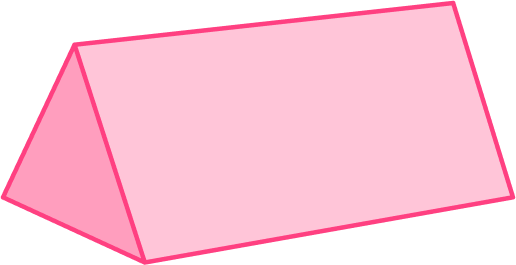
4. Which shape is a non-polyhedron?


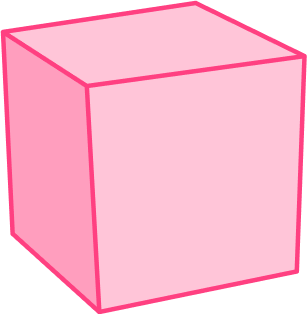





Non-polyhedron shapes have at least one curved face, and these do not.

This shape is a non-polyhedron:
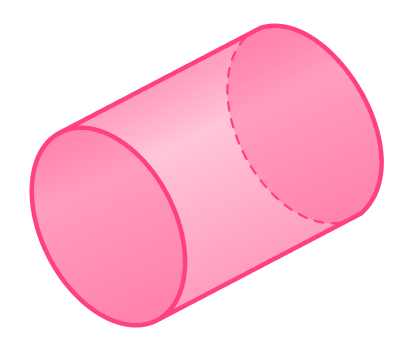
5. How many cylinders are in the composite shape?





A cylinder is a non-polydron shape with two circular bases and one curved face.

There is only 1 cylinder in this composite shape.
6. Which shape is a rectangular prism?








A rectangular prism is a 3D shape, and a parallelogram is not 3D.
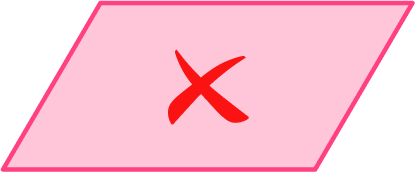
A rectangular prism has 6 rectangular faces, but a cylinder has no rectangular faces and a square pyramid only has one.

This shape is a rectangular prism. It is also classified as a cube.
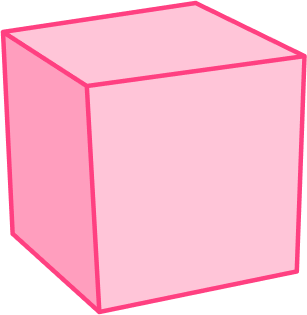
3D shape FAQs
The main difference between 2D and 3D shapes lies in their dimensions. 2D shapes are flat and exist only on a plane, with length and width. They have no depth or thickness. 3D shapes have length, width, and height. They are solid, occupy space, and have a three-dimensional structure.
To identify a 3D shape, you need to consider its properties. Look for features like faces (the flat surfaces), edges (the lines where two faces meet), and vertices (the points where edges meet). The number and arrangement of faces, edges, and vertices can help you determine the specific 3D shape.
The next lessons are
Still stuck?
At Third Space Learning, we specialize in helping teachers and school leaders to provide personalized math support for more of their students through high-quality, online one-on-one math tutoring delivered by subject experts.
Each week, our tutors support thousands of students who are at risk of not meeting their grade-level expectations, and help accelerate their progress and boost their confidence.

Find out how we can help your students achieve success with our math tutoring programs.
[FREE] Common Core Practice Tests (3rd to 8th Grade)
Prepare for math tests in your state with these 3rd Grade to 8th Grade practice assessments for Common Core and state equivalents.
Get your 6 multiple choice practice tests with detailed answers to support test prep, created by US math teachers for US math teachers!